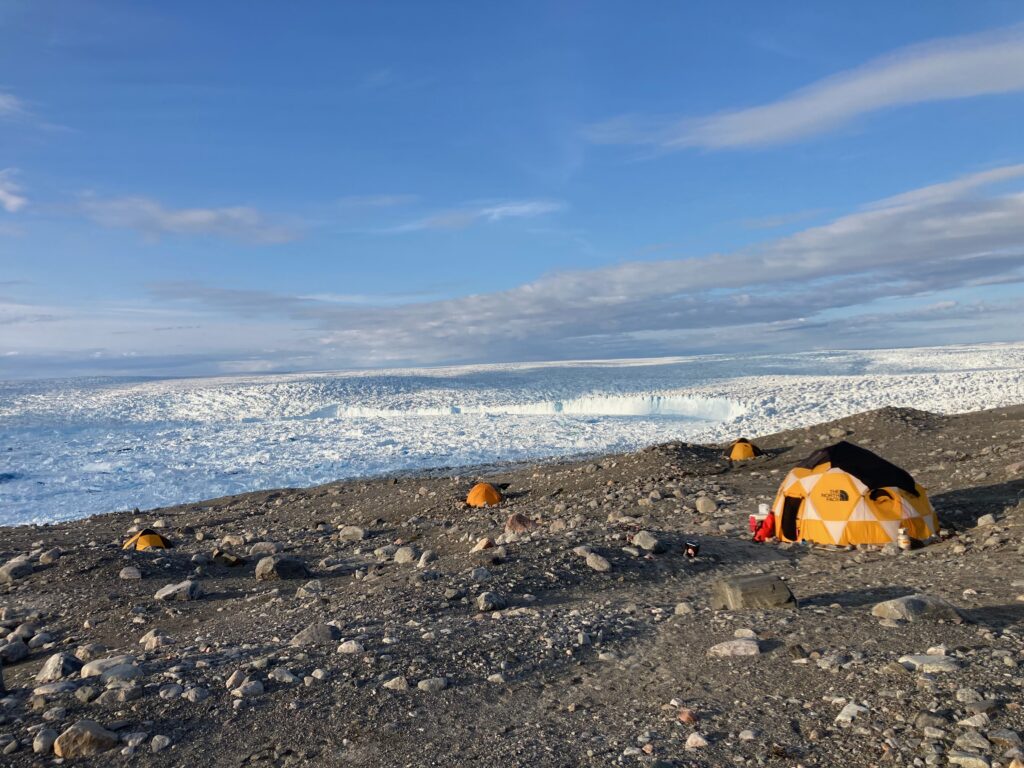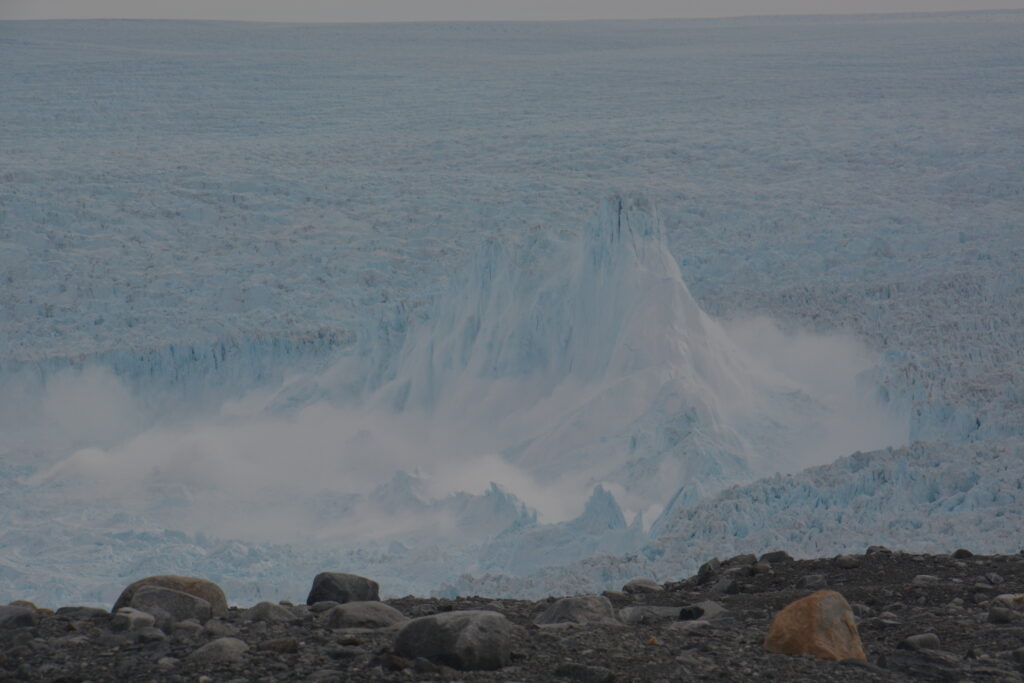Where the world becomes small, your mind becomes larger. For me, this is the effect of camping for two and a half weeks, five kilometres away from the Greenland ice sheet margin. Just two decades ago, this area was buried beneath a blanket of ice; now, it’s a rugged landscape of rock and water. Our theatre is the 130-metre-high calving front rising up from the fjord filled with icebergs. There is no phone network, no distractions. We were dropped off by a helicopter loaded with all our camping gear, scientific equipment and food. Our drinking water comes from a nearby lake, and we wash and swim in another.

Our team, consisting of four scientists, forms a small community in this remote wilderness. When we arrive, it’s as if we create our new home and when we depart, all our traces vanish. Our home is a tent, positioned near Sermeq Kujalleq in Kangia, 60 km east of the town of Ilullisat in Western Greenland. Running the camp life takes half of the day, or maybe it is just that the need for efficiency seems to fade. In this pristine environment, I can sit on a rock and lose myself in contemplation for an hour, then make some coffee and stare at the glacier again. On days with not many tasks, while the sensors are measuring, we go on hikes to explore. There are no trails, there is no detailed map. We pick some points of interest on the satellite image, load them in the GPS and set off with just a general direction guiding us. At first glance, the landscape adjacent to the ice sheet appears desolate, a tableau of boulders, cliffs and streams. But if you wander around, there is so much to see. Small flowers are growing in sheltered areas, along the lake there is a plover calling, a grouse suddenly flies up from behind a rock, and we even spot a snowshoe hare and a Tutu, the Greenlandic reindeer. Life, it seems, finds a way even in this unforgiving terrain, and these unexpected encounters leave big impressions.




Unexpected encounters around camp and the ice sheet margin. © 2023, Janneke van Ginkel, all rights reserved
During the Arctic summer, the sun never sets and when the skies are clear, we can watch the calving spectacle all day long. The view and sounds of a such a large calving glacier are something that will remain in my memories for a long time. Enormous blocks of ice break off and due to the buoyancy force, the blocks rise up 2-3 times the height of the calving front, tumble over and crumble into pieces. This process can easily last thirty minutes and every time we remain equally impressed. Sermeq Kujalleq is one of the fastest moving glaciers in the world and has a moving speed of 20-30 metres per day, resulting in large outflux of ice into the fjord.

However, the reality of fieldwork is not always as idyllic as these moments of wonder. Over two days, there was more rain than the region typically receives in an entire year. The hill of the camp transformed into a one big waterfall, and streams were flowing beneath our tents. With snow shovels and ice axes we dug canals and built dikes from rocks to deviate the streams. We were soaked to the bone, but luckily kept the sleeping bags dry. A great example of ‘type II fun’: at that time, we were between discomfort and agony, but afterwards existed the great feeling of pride and accomplishment. Nevertheless, the world becomes a greater place when the sun comes out again.
The weather was the ultimate decision-maker during our weeks out there. It dictated helicopter flights and, consequently, the success of our scientific purpose. Thanks to our proactive pilot, we successfully deployed two seismic networks. However, our return pickup proved to be an adventure in itself. My colleague Ana, a fellow seismologist, and I were on the glacier as sudden fog and rain came in. On a white glacier, this can quickly become a dangerous situation, as the fog erased any sense of up, down, left, or right. Luckily, we could escape the glacier just in time to land on the nearest ice-free hill. The weather forecast promised the fog would dissipate in a few hours, and so, we remained optimistic. From the beginning, Ana, the helicopter pilot and I found the situation fun and a pretty good adventure. We had spent two and a half weeks in this remote wilderness; a little more time wouldn’t hurt. We were well-prepared with warm clothing and, through some improvisation, managed to spend the night in relative comfort, since the fog persisted. We put together all the food that we had and rationed it among the three of us. The dinner was excellent: a shared portion of a dried meal and a sandwich split in 3, the same menu for breakfast. We entertained ourselves by building towers with stones, and had some good conversations while sitting in the helicopter. Meanwhile, the largest calving event during our stay happened, but hidden by the fog. In the morning it cleared up and there was a window to fly back to Ilulissat. All three of us even felt some sadness that this crazy emergency bivouac adventure came to an end.


Stranded near the glacier due to the sudden incoming fog. To entertain ourselves, we build stone towers. © 2023, Janneke van Ginkel, all rights reserved
But why were four scientists out there? I was joining the COEBELI team from the University of Zürich on their field campaign to Sermeq Kujalleq. It is a multidisciplinary project that investigates short-term ice stream dynamics, and I am joining as a seismologist. We deployed around 30 seismic sensors 30 kilometres upstream on the outlet glacier. These instruments continuously recorded vibrations within the glacier, generated by varying processes, like icequakes, crevassing, calving icebergs, flowing water, and the glacier’s movement over bedrock. With the acquired data, we aim to monitor subglacial conditions and spatiotemporal variabilities of the ice mass. The results will provide a unique observational-based perspective on subglacial processes, which influence large-scale ice dynamics and eustatic sea level rise. Beside the seismic data we acquired terrestrial radar data (a radar that scans the glacier every minute from a hill close to camp), GPS measurements, time-lapse imagery and we scanned calved icebergs with an infrared camera.



Deployment of the seismic sensors on Sermeq Kujallek in Kangia. © 2023, Ana Nap, all rights reserved
Fieldwork in such a remote and unpredictable environment rarely follows a script. Yet, the ability to adapt and appreciate the small and grand wonders of this Arctic wilderness made it an unforgettable expedition.
This great experience wasn’t possible without the COEBELI project team of the University of Zürich. Special thanks to our field team: Martin Lüthi, Ana Nap and Antione Zaninetti, together we managed all the unexpected.
Janneke van Ginkel is a postdoctoral researcher at ETH Zurich and her field trip took place in summer 2023 with financial support from a Polar Access Fund grant.
Header photograph: © 2023, Janneke van Ginkel, all rights reserved